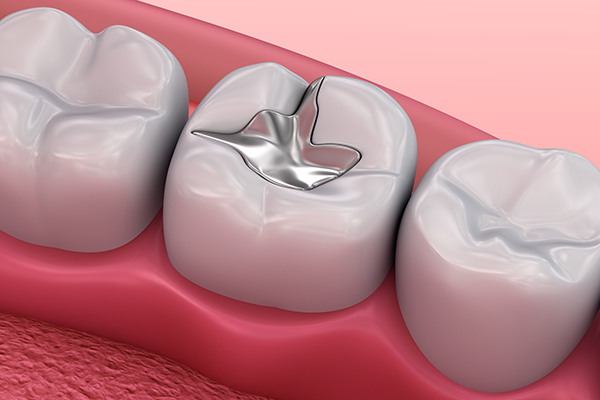Understanding a Silver Versus Tooth-Colored Dental Filling

The dental filling has advanced over time. Silver or dental amalgams and tooth-colored fillings (made from composite resin) are two standard options available. It is vital to comprehend their distinctions before deciding on one. You should also consult your dentist about what would be the best filling material for you.
Silver amalgam fillings
Silver amalgam fillings have been popular for decades. However, silver amalgam is not primarily made up of silver, despite the name. Mercury makes up about half the substance, with silver, copper, and tin making up the rest. An amalgam filling is easy to work with, long-lasting, and affordable.
However, the dark hue can cause the attached tooth to turn gray. Additionally, a silver filling might be seen while yawning, laughing, or conversing depending on its location. When the temperature changes, a silver amalgam filling will expand and compress. Therefore, silver fillings might be distorted by hot or cold food or drinks, which might weaken the teeth or cause structural damage eventually.
Tooth-colored fillings
Porcelain and plastic are often used for tooth-colored fillings. Even though there have been no reports of silver filling allergies, some patients prefer the metal-free feel of composite fillings. The dentist can use a shade of tooth-colored composite that is comparable to the natural tooth color, which is the most obvious benefit of this material. It will not show through the teeth, unlike metal.
Placing the dental filling
The dentist will thoroughly clean the teeth before putting a dental filling in, removing any decaying tissue and germs. They will reshape the interior of the tooth to accept the filling. Then, they will apply a bonding agent to the tooth. This moderate chemical solution will roughen the tooth's interior, making it easier for the filling to adhere. The dentist will apply the filling material once the basic cleaning and prepping steps are complete.
What are the distinctions between dental fillings?
Dentists use both kinds of fillings to restore decaying teeth. However, there are significant variances among the materials.
Method of tooth preparation
When comparing silver and tooth-colored dental fillings, it is crucial to examine how much tooth preparation is required. Before applying fillings, dentists must use a drill to eliminate decay. Since tooth-colored fillings bond to the teeth, less natural tooth structure needs to be removed. Silver fillings do not adhere to the teeth. Rather, they are inserted into the cavity. The placement process requires scraping off more of the natural tooth structure.
Durability
Composite resin fillings are less durable than silver amalgam fillings. Silver fillings may last up to 15 years on average. Composite resin fillings, however, only survive for 10 years. Silver fillings are ideal for back teeth because of their strength. They are more resistant to chewing pressures and are less prone to breaking orfallingl out.
The appearance
Silver fillings do not match the natural color of the teeth. When patients chat and smile, their fillings may be visible. Fillings made of composite resin are color-matched to the surrounding natural teeth. That said, these fillings may discolor with time. Patients are advised to refrain from smoking and from consuming staining foods or beverages. For example, red wine stains teeth and composite resin materials.
The fit
Dentists will ensure that silver amalgam fillings fit as closely as feasible. It is normal, though, to leave a micro-gap. Although the gap is not apparent to the human eye, bacteria can invade the tooth via the hole and can cause decay. Tooth-colored fillings do not leave any space. As a result, decay has a harder time compromising the natural tooth.
Tooth sensitivity
Following the placement of silver fillings, some patients report tooth sensitivity. This normally stops after a while, though. Those with composite resin tooth fillings do not typically have the same sensitivity problems. Many patients may resume eating and drinking without pain as soon as the numbing medication wears off.
Stability
Silver fillings are temperature sensitive. When the temperature changes, the filling substance expands and contracts, potentially damaging the teeth. Composite resin materials adhere to the teeth and do not react to temperature fluctuations, even under severe temperatures.
Visit the dental office for a consultation
Before opting for dental fillings, you should review your options. Consider the amount of tooth preparation required and the fit, appearance, and longevity of the filling. Also consider tooth sensitivity after the filling and the filling's general stability. After weighing these variables, consult with your dentist to choose the best filling material.
Request an appointment here: https://sonorandesertdentistry.com or call Sonoran Desert Dentistry at (480) 439-0117 for an appointment in our Scottsdale office.
Check out what others are saying about our dental services on Yelp: Composite Fillings in Scottsdale, AZ.
Recent Posts
Dental fillings protect oral health by repairing teeth compromised by cavities and decay, preventing further damage, and helping patients maintain comfortable, confident smiles. This essential treatment seals vulnerable areas, supports tooth structure, and stops bacteria from spreading deeper into tooth layers. By addressing cavities early and restoring compromised enamel, dental fillings preserve the longevity of…
If you are self-conscious about your smile because of a damaged or chipped tooth, you should know that a dentist can use dental fillings to quickly correct these minor flaws and restore your smile's appearance.Dental filling application is an in-office technique in which dentists use a tooth-colored resin substance to fix minor flaws in the…
A dental filling is important in achieving good dental health and a painless smile. This dental restoration can seal the tooth and protect it from further decay. Knowing when to get fillings can help you achieve your smile goals earlier. Here are the signs your tooth may need a dental filling right away.Pain often develops…
When individuals experience cavities and other problems that affect their teeth, dentists use a dental filling to repair and restore them. This helps preserve damaged teeth and prevents their loss. Dental fillings are the most common type of dental work: according to the Centers for Disease Control and Prevention, over 90% of Americans have had…


